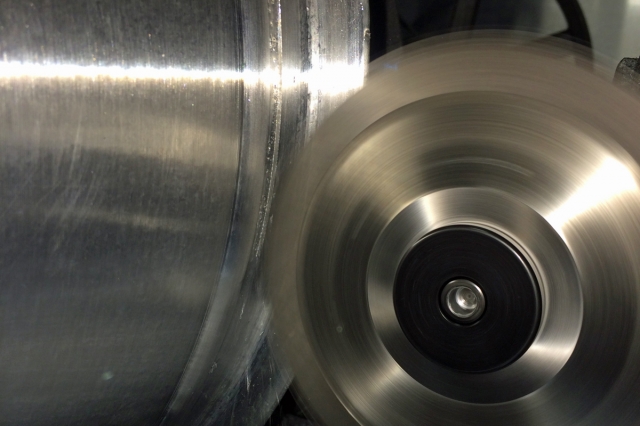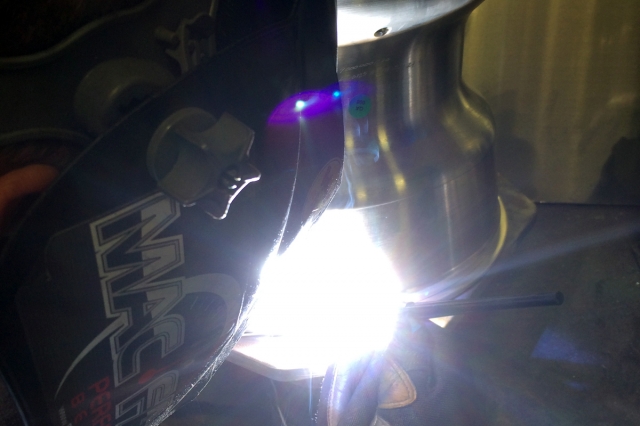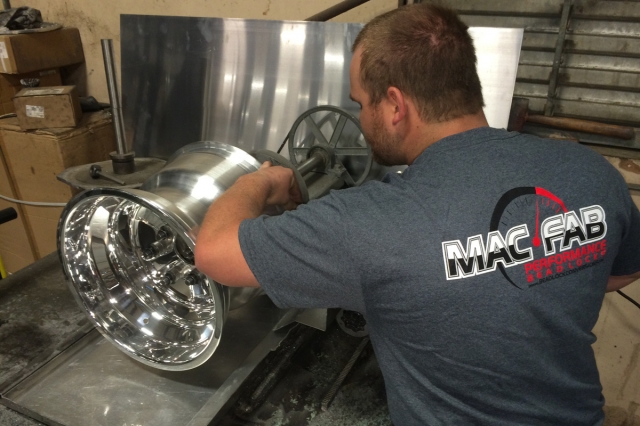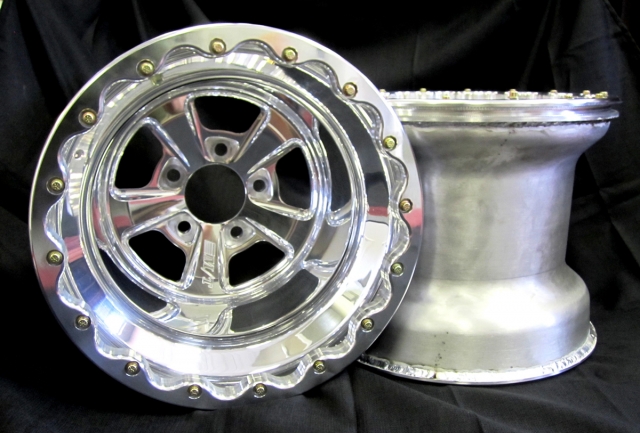So you’re reading the text in the lead graphic up above and wondering “what does security have to do with beadlocking my wheels?”
Mac-Fab Performance‘s Tommy Kirk explains, “When the small tire racing world came about, you had all these racers trying to mount small tires on a wide rim – guys were taking ten-inch-wide tires and trying to mount them on a twelve-inch rim. If you’ve ever watched Top Fuel cars, you know how the tire grows, right? What happens is as the tire starts to grow in diameter, it sucks the bead away from the tire, causing a loss of air pressure, and ultimately a massive wreck on the top end, because it usually happens at full speed. Even screwing the tire to the rim doesn’t help this. And if you don’t run a tube, you just had a blowout.”

Mac-Fab’s proprietary machinery was built in-house by Kirk at the company’s facility in North Carolina.
The problem occurs most often in small-tire classes like X275, Outlaw Drag Radial, and Radial Vs. The World. As Kirk mentions, racers used screws to hold the tire to the rim in the past, but that line of thinking is outdated, and according to Kirk, is unsafe. Since radial racers don’t use tubes within the tire, the problem is even more pronounced in those applications.

The entire outer bead surface of the wheel is removed in preparation for the weld-on ring’s placement – depth depends upon the wheel and the required dimensions upon completion.
“The radial tire is so heavy, it’ll break the screws off. You’ve got two things – the massive weight of the tire breaking the screws, and the potential for spinning the tire on the rim,” he says.
The dual advantages to using the beadlock system are the secure method of clamping the tire to the wheel and the positive retention of the air inside the tire’s carcass.
As Project BlownZ is getting quicker and faster and entering the realm where safety is a critical issue for us, we knew it was time to explore the beadlock option for our Mickey Thompson Pro 5 Drag wheels. Our wheels were shipped to Mac Fab, where Kirk chucked them up on his one-of-a-kind proprietary machinery and set us up to achieve those ET’s without safety concerns.
With a normal wheel design, a radial tire is installed with a mounting machine and drops into what’s called the drop center of the wheel. As air pressure is introduced through the tire’s valve, air pressure pushes out against the tire’s carcass, causing it to “pop” over the safety hump that’s machined into both sides of the drop center. Air pressure subsequently holds the tire against the outer bead surface of the wheel, and it is through this face that racers typically drill holes and install screws for positive retention.
In a beadlock conversion like the process performed by Mac Fab, one or both wheel faces are completely cut off, leaving just the drop center area of the wheel prior to installation of the beadlock system.

Each of the inserts is pressed into the bolt-on ring – these positively locate within the holes on the weld-in ring to secure the tire in place.
Mac Fab takes weld-in rings (single or double, depending), positions them into place, and uses a MIG or TIG welding process to secure the new ring(s) to the wheel shell.
This provides a positive mounting surface for the tire to sit on. In order to remove the wheel sections and weld on the new rings, a high-speed steel blade is used with Kirk’s machinery to prepare the wheel for the conversion. In most cases, approximately one-half inch of material is removed from each side of the wheel to allow the new weld-in sections to fit properly.
There’s an automatic positioning system to rotate the wheel during the welding process to ensure consistency and uniformity.
When mounting a tire to a beadlocked wheel, the bead section of the tire is pulled up and over the weld-in ring, positioning the tire’s inner bead against the weld-in ring’s outer surface and providing a positive stop to prevent the tire from pulling inward as it grows.
The weld-in ring is drilled and tapped with 16 bolt holes, which the outer ring attaches to in order to clamp the tire.
The outer ring uses 16 press-in inserts that protrude approximately 1/8-inch above the ring’s surface, so that when the tire bead is set into place, the ring positively locates the bead into place and retains it before it’s bolted down.
“It depends on how thick the weld-on ring is – we have a 3/8-inch and a 1/2-inch ring to choose from. We do a lot of narrowing and widening of wheels to try to get a specific backspace or offset, and how much we cut off directly reflects what we’re trying to do with the wheel. A ten-inch wheel will get approximately one-half inch cut from each side where the bead of the tire actually sits,” Kirk says.
These beadlock products have been extensively tested on some of the quickest and fastest radial cars in the country, from DeWayne Mills’ Camaro to Steve Jackson’s Mustang, Ron Rhodes’ record-setting leaf spring X275 Camaro and dozens of other cars throughout the small-tire world.
For those looking to have a beadlock conversion performed on their existing wheels, Kirk stresses that it’s best to use a wheel with six inches or less of backspace. The company’s beadlock system will fit over just about any caliper combination, as well, and has been designed to remove as much rotating weight as possible from the assembly.

The weld-in sections are attached using a MIG or TIG process depending upon the wheel being modified.
They’ve beadlocked over 3,000 sets of wheels in the last eight years, and typically appear on-site at Duck X Productions’ events and others to perform the process on-site as a racer service – they did 26 sets of wheels on-site in two days at the Lights Out V race. As Kirk is a racer himself in the hotly-contested X275 class, he understands the need for quality work at an affordable price.
The ultimate goal is to provide the customer with a safe and effective system for tire retention. Each piece of the assembly is made in-house; as Mac-Fab is a division of Kirk’s much larger contract manufacturing business, the machines on-site are capable of handling anything the company needs to build.




















